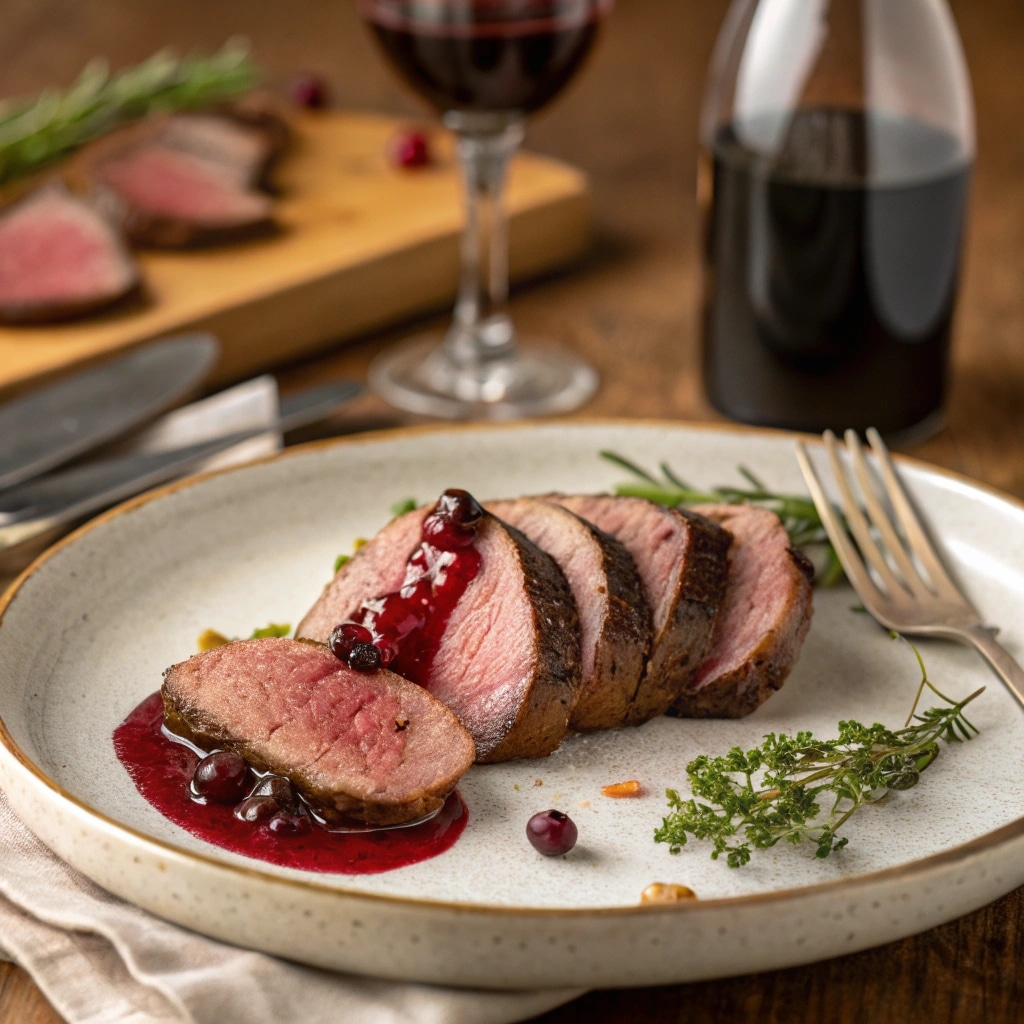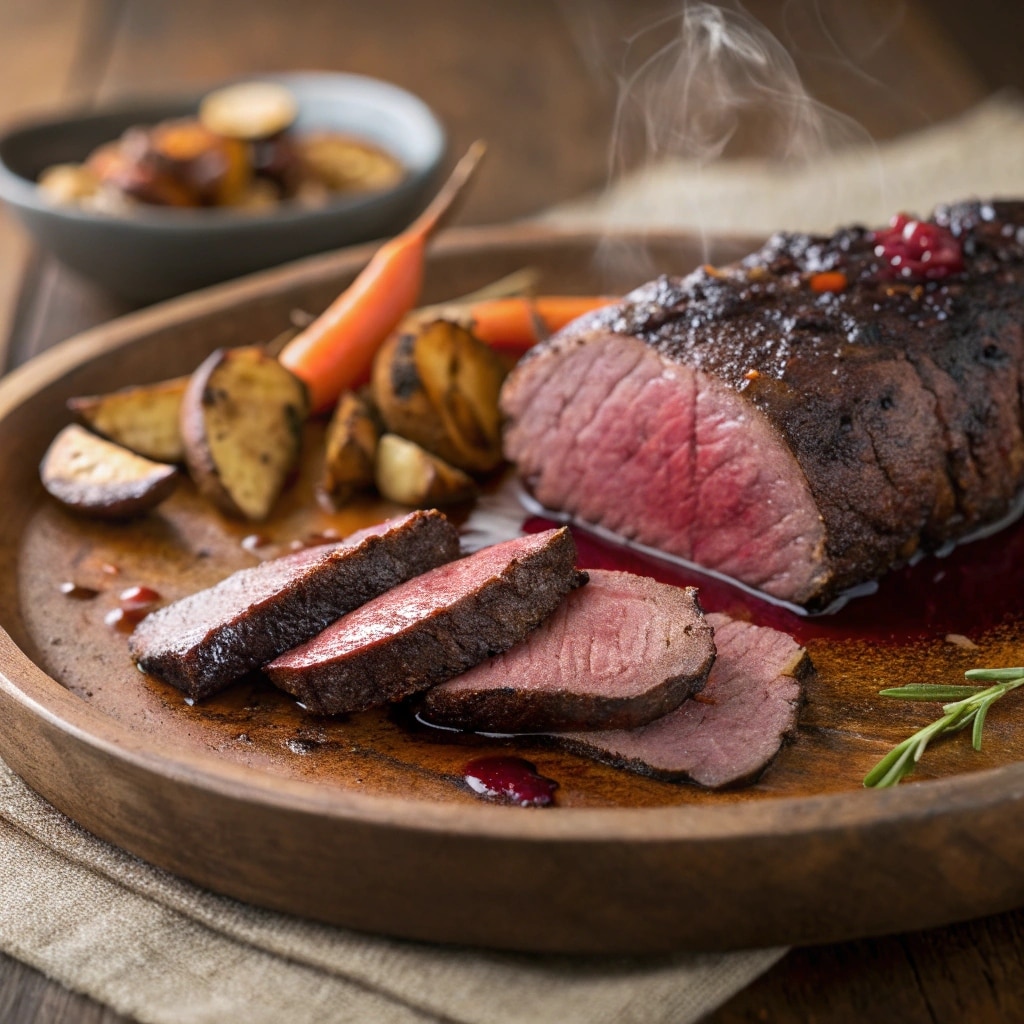Elk Tenderloin Recipe: A Gamey Delight
Jump to Recipe
Once, I found myself wandering through the dull and uninspiring world of cooking, looking for that special dish that could spark my love for it again. That’s when I discovered the rich and juicy delight of elk tenderloin.
I met this amazing cut of meat by chance at a local farmers’ market, and I’ve loved it ever since. The delicious flavours turned my kitchen into a special place, making every meal feel like an exciting journey.
Preparing elk tenderloin can feel as challenging as trying to find the animal itself. But don’t worry, my fellow food lovers, because I have mapped out the path and am here to help you navigate through the confusion.
Using my reliable skillet and a few ingredients, I set out to master the art of cooking this lean and tasty protein. The results were truly amazing. Put on your apron and get ready for some fun, because we’re about to start a delicious adventure that will make your taste buds happy.

Important Information You Should Be Aware Of
-
I found that elk tenderloin is a very lean cut of meat, so it needs careful preparation to keep its tender texture and juiciness. Avoiding overcooking is important because it can make the meal tough and dry, which is not what you want with a high-quality game cut.
-
From what I’ve seen, marinating the elk tenderloin makes a big difference. I like to use a blend of olive oil, garlic, rosemary, and thyme for a few hours, or overnight if I can. This adds strong flavours to the meat and makes it more tender, so every bite is tasty and soft.
-
I’ve found that cooking elk tenderloin quickly at high heat is the best way to do it. Cooking it on all sides in a hot cast iron skillet creates a lovely crust and keeps the inside moist. Next, moving it to a preheated oven helps create a better cooking environment, making sure I achieve that perfect medium-rare doneness I want.
-
I like to make a bright, tart cherry sauce to go with the natural gamey taste of elk meat. The sweet and tangy flavours balance the richness, enhancing the overall dish. I typically begin making the sauce on the stove while the meat cooks in the oven. This helps me save time and makes meal preparation go smoothly.
-
Cutting the meat properly is just as important as cooking it well. After cooking the elk tenderloin to my preference, I always allow it to rest before slicing. I cut it across the grain to make sure every piece is as tender as it can be. This not only showcases the perfect cooking of the tenderloin but also emphasises my effort and care in the preparation.
Choosing the Best Elk Tenderloin
When I select elk tenderloin, I look for a deep, dark colour and a fresh, gentle smell that suggests its wild background without being too strong. I like to get my elk meat from trusted hunters or butchers who follow sustainable practices. It’s not only about taste; it’s also about honouring the animal and the way things are done.
Getting the Meat Ready for Cooking
Before I cook, I always let my elk tenderloin sit out of the fridge until it reaches room temperature. This makes sure the food cooks evenly. I trim away any extra fat or silver skin that could change the texture. Elk is a gamey meat that doesn’t need much trimming, but taking care of this detail makes a difference in the final dish.
Why Marinating Matters
The key to a tasty elk tenderloin is the marinade. A mix of olive oil, crushed garlic, rosemary, and a bit of balsamic vinegar makes my tenderloin unique. This mixture not only makes the meat tender but also adds a rich, pleasant flavour that goes well with its gamey taste.
Methods for Achieving the Ideal Sear
I really love using my cast iron skillet for cooking elk tenderloin. When the pan is really hot, I place the meat in and listen to that pleasing sizzle, searing each side until it’s a nice golden-brown. It’s important not to overcrowd the pan, as this can cause steaming instead of searing.
Keeping an Eye on the Internal Temperature
When cooking game meats like elk, it’s important to avoid overcooking. I use a meat thermometer to make sure the temperature hits 130°F for the ideal medium-rare. Allowing it to rest afterwards helps the juices spread out, keeping the tenderloin juicy and preventing it from drying out.
Delicious Side Dishes that Go Well with Elk
Choosing the right combinations can elevate a simple meal into something special. I really like a filling root vegetable hash or a wild mushroom risotto with my elk tenderloin. They complement the meat’s earthiness and are strong enough to pair well with the gamey taste.
Making it Your Own with Homemade Sauce
A rich port wine reduction with fresh herbs and a touch of blackberry jam can take the dish to a whole new level. The sauce’s complexity highlights the elk’s unique profile while keeping its natural flavours intact.
Creating a Meal for Every Season
I change the side dishes for my elk tenderloin based on the season. In autumn, spiced pumpkin puree adds warmth to the dish. In the summer, a fennel and citrus salad provides a refreshing balance to the rich meat.
Learning about the health benefits
Enjoying the flavour is my main focus, but I also recognise that elk tenderloin is leaner and has more protein than beef, which makes it a better option for those who care about their health. Additionally, it provides important nutrients such as iron and B vitamins, which I see as a great benefit.
What are some tips for cooking elk tenderloin?
-
Always allow the meat to rest before and after cooking to achieve the best texture.
-
Embrace strong seasonings and marinades that complement the rich taste of elk.
-
Watch your cooking times closely – elk tenderloin can change from just right to overcooked very quickly.
-
Add seasonal sides to make the meal interesting and balanced throughout the year.
-
Try different sauces, but make sure not to mask the natural taste of the elk.
Concluding Thoughts
Cooking with elk tenderloin has opened my eyes to new flavours. The rich and varied flavours create a wonderful meal that is sure to impress. Although it may seem intimidating at first, this impressive meat is easy to cook with a little knowledge. Elk tenderloin, whether roasted, grilled, or pan-seared, offers a delicious taste that is both juicy and connects us to our culinary roots.
I really enjoy a straightforward pan-sear with a touch of garlic and herbs. It always fills my kitchen with amazing smells and my plate with a healthy and satisfying meal. Turn on the stove or heat up the grill, and let the journey into the tasty world of elk tenderloin motivate you to cook.

Seared Elk Tenderloin with Cherry Sauce
Ingredients
Method
- In a bowl, mix olive oil, crushed garlic, rosemary, thyme, and balsamic vinegar.
- Rub the marinade all over the elk tenderloin.
- Cover and refrigerate for at least 3 hours, or overnight for best results.
- Remove elk from the fridge and let it sit for 30–60 minutes before cooking.
- Preheat your oven to 375°F (190°C).
- Trim any excess fat or silver skin from the meat.
- Heat a cast iron skillet on high until very hot.
- Add a bit of olive oil to the pan.
- Sear the tenderloin on all sides (about 3–4 minutes per side) until a golden crust forms.
- Transfer the skillet to the preheated oven.
- Roast for 5–10 minutes or until internal temperature hits 130°F (54°C) for medium-rare.
- Remove and let it rest for 5–10 minutes before slicing.
- While the meat is in the oven, place cherries and wine in a small saucepan over medium heat.
- Add thyme, rosemary, and blackberry jam.
- Simmer until slightly thickened (about 10–12 minutes). Stir occasionally.
- Cut the elk tenderloin against the grain into thick slices.
- Serve with the warm cherry sauce spooned over the top.
Notes
- Always rest the meat before cutting to keep it juicy.
- Don’t overcrowd the skillet while searing. If your tenderloin is too long, cut it in half.
- Pair with seasonal sides like mushroom risotto or root vegetable hash for a hearty meal.
- You can swap the cherry sauce for a port wine reduction if cherries are out of season.
FAQ
What is the best method for cooking elk tenderloin?
Elk tenderloin tastes best when cooked to medium-rare or medium, which brings out its rich flavours. I recommend searing the tenderloin on high heat to create a tasty crust, then finishing it in the oven for a juicy and flavourful result.
Is elk meat tough?
Elk meat can become tough if cooked too long, but when prepared properly, it is very tender. It’s important not to overdo it and to let it rest after cooking. This allows the juices to spread out, resulting in a tender bite.
Should I marinate elk tenderloin before cooking it?
Elk tenderloin doesn’t need marination, but it can improve the meat’s flavour. A mix of olive oil, garlic, and fresh herbs can enhance the elk’s natural flavour and tenderness.
What are the health benefits of eating elk meat?
Elk meat is a healthy source of protein that has less fat and cholesterol compared to regular beef. It is full of vitamins and minerals, making it a strong and healthy choice for anyone looking for nutritious meats.
What can I do to prevent a gamey taste in elk tenderloin?
To reduce the strong flavour, consider adding acidic ingredients such as lemon juice or vinegar to your marinade. These can help reduce the strong flavour, making it easier to enjoy for those who are trying game meats for the first time.
What side dishes go well with elk tenderloin?
Roasted root vegetables or a hearty risotto pair well with the flavour of elk tenderloin. You can also try it with a wild mushroom sauce or a fresh rocket salad to enhance the flavours.
How long should you cook elk tenderloin?
To cook a medium-rare elk tenderloin, sear it for about 3-4 minutes on each side, then place it in the oven at 375°F for 5-10 minutes. Always use a meat thermometer to ensure the internal temperature reaches 145°F.
What seasoning is best for elk?
Spices such as rosemary, thyme, and juniper berries enhance the flavour of elk meat beautifully. Season well to match the strong flavour of elk. A little sea salt and cracked black pepper always add a nice touch.
Can elk tenderloin be grilled instead of roasted?
Grilling elk tenderloin on medium-high heat creates a delicious charred flavour. Make sure to watch it carefully to avoid overcooking and to keep it juicy.
What is the best thickness for elk tenderloin steaks?
It’s best to cut elk tenderloin steaks to a thickness of about 1 to 1 1/2 inches. This size helps each steak cook evenly, allowing for a tasty sear on the outside while keeping it tender on the inside.